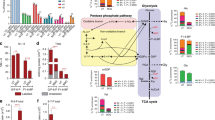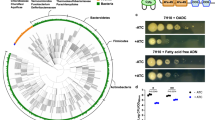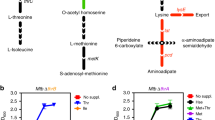Abstract
New chemotherapeutics are urgently required to control the tuberculosis pandemic. We describe a new pathway from trehalose to α-glucan in Mycobacterium tuberculosis comprising four enzymatic steps mediated by TreS, Pep2, GlgE (which has been identified as a maltosyltransferase that uses maltose 1-phosphate) and GlgB. Using traditional and chemical reverse genetics, we show that GlgE inactivation causes rapid death of M. tuberculosis in vitro and in mice through a self-poisoning accumulation of maltose 1-phosphate. Poisoning elicits pleiotropic phosphosugar-induced stress responses promoted by a self-amplifying feedback loop where trehalose-forming enzymes are upregulated. Moreover, the pathway from trehalose to α-glucan exhibited a synthetic lethal interaction with the glucosyltransferase Rv3032, which is involved in biosynthesis of polymethylated α-glucans, because key enzymes in each pathway could not be simultaneously inactivated. The unique combination of maltose 1-phosphate toxicity and gene essentiality within a synthetic lethal pathway validates GlgE as a distinct potential drug target that exploits new synergistic mechanisms to induce death in M. tuberculosis.
This is a preview of subscription content, access via your institution
Access options
Subscribe to this journal
Receive 12 print issues and online access
$259.00 per year
only $21.58 per issue
Buy this article
- Purchase on Springer Link
- Instant access to full article PDF
Prices may be subject to local taxes which are calculated during checkout






Similar content being viewed by others
Accession codes
References
Dye, C. Global epidemiology of tuberculosis. Lancet 367, 938–940 (2006).
Sassetti, C.M., Boyd, D.H. & Rubin, E.J. Genes required for mycobacterial growth defined by high density mutagenesis. Mol. Microbiol. 48, 77–84 (2003).
Sassetti, C.M. & Rubin, E.J. Genetic requirements for mycobacterial survival during infection. Proc. Natl. Acad. Sci. USA 100, 12989–12994 (2003).
Tong, A.H. et al. Global mapping of the yeast genetic interaction network. Science 303, 808–813 (2004).
Boone, C., Bussey, H. & Andrews, B.J. Exploring genetic interactions and networks with yeast. Nat. Rev. Genet. 8, 437–449 (2007).
Belanger, A.E. & Hatfull, G.F. Exponential-phase glycogen recycling is essential for growth of Mycobacterium smegmatis. J. Bacteriol. 181, 6670–6678 (1999).
Garg, S.K., Alam, M.S., Kishan, K.V. & Agrawal, P. Expression and characterization of alpha-(1,4)-glucan branching enzyme Rv1326c of Mycobacterium tuberculosis H37Rv. Protein Expr. Purif. 51, 198–208 (2007).
Sambou, T. et al. Capsular glucan and intracellular glycogen of Mycobacterium tuberculosis: biosynthesis and impact on the persistence in mice. Mol. Microbiol. 70, 762–774 (2008).
Pan, Y.T. et al. Trehalose synthase converts glycogen to trehalose. FEBS J. 275, 3408–3420 (2008).
Pan, Y.T. et al. Trehalose synthase of Mycobacterium smegmatis: purification, cloning, expression, and properties of the enzyme. Eur. J. Biochem. 271, 4259–4269 (2004).
Jarling, M., Cauvet, T., Grundmeier, M., Kuhnert, K. & Pape, H. Isolation of mak1 from Actinoplanes missouriensis and evidence that Pep2 from Streptomyces coelicolor is a maltokinase. J. Basic Microbiol. 44, 360–373 (2004).
Usui, T. et al. Proton magnetic resonance spectra of D-gluco-oligosaccharides and D-glucans. Carbohydr. Res. 33, 105–116 (1974).
Bosch, A.M. Classical galactosaemia revisited. J. Inherit. Metab. Dis. 29, 516–525 (2006).
Slepak, T., Tang, M., Addo, F. & Lai, K. Intracellular galactose-1-phosphate accumulation leads to environmental stress response in yeast model. Mol. Genet. Metab. 86, 360–371 (2005).
Yarmolinsky, M.B., Wiesmeyer, H., Kalckar, H.M. & Jordan, E. Hereditary defects in galactose metabolism in Escherichia coli mutants, II. Galactose-induced sensitivity. Proc. Natl. Acad. Sci. USA 45, 1786–1791 (1959).
Streeter, J.G. & Gomez, M.L. Three enzymes for trehalose synthesis in Bradyrhizobium cultured bacteria and in bacteroids from soybean nodules. Appl. Environ. Microbiol. 72, 4250–4255 (2006).
Karakousis, P.C., Williams, E.P. & Bishai, W.R. Altered expression of isoniazid-regulated genes in drug-treated dormant Mycobacterium tuberculosis. J. Antimicrob. Chemother. 61, 323–331 (2008).
Boshoff, H.I. et al. The transcriptional responses of Mycobacterium tuberculosis to inhibitors of metabolism: novel insights into drug mechanisms of action. J. Biol. Chem. 279, 40174–40184 (2004).
Manjunatha, U., Boshoff, H.I. & Barry, C.E. The mechanism of action of PA-824: novel insights from transcriptional profiling. Commun. Integr. Biol. 2, 215–218 (2009).
Kumar, A. et al. Heme oxygenase-1-derived carbon monoxide induces the Mycobacterium tuberculosis dormancy regulon. J. Biol. Chem. 283, 18032–18039 (2008).
Voskuil, M.I. et al. Inhibition of respiration by nitric oxide induces a Mycobacterium tuberculosis dormancy program. J. Exp. Med. 198, 705–713 (2003).
Dahl, J.L. et al. The role of RelMtb-mediated adaptation to stationary phase in long-term persistence of Mycobacterium tuberculosis in mice. Proc. Natl. Acad. Sci. USA 100, 10026–10031 (2003).
Boshoff, H.I., Reed, M.B., Barry, C.E. III & Mizrahi, V. DnaE2 polymerase contributes to in vivo survival and the emergence of drug resistance in Mycobacterium tuberculosis. Cell 113, 183–193 (2003).
Murphy, H.N. et al. The OtsAB pathway is essential for trehalose biosynthesis in Mycobacterium tuberculosis. J. Biol. Chem. 280, 14524–14529 (2005).
Arguelles, J.C. Physiological roles of trehalose in bacteria and yeasts: a comparative analysis. Arch. Microbiol. 174, 217–224 (2000).
Jackson, M. & Brennan, P.J. Polymethylated polysaccharides from Mycobacterium species revisited. J. Biol. Chem. 284, 1949–1953 (2009).
Schneider, D., Bruton, C.J. & Chater, K.F. Duplicated gene clusters suggest an interplay of glycogen and trehalose metabolism during sequential stages of aerial mycelium development in Streptomyces coelicolor A3(2). Mol. Gen. Genet. 263, 543–553 (2000).
Elbein, A.D., Pastuszak, I., Tackett, A.J., Wilson, T. & Pan, Y.T. The last step in the conversion of trehalose to glycogen: a mycobacterial enzyme that transfers maltose from maltose-1-phosphate to glycogen. J. Biol. Chem. published online, doi:10.1074/jbc.M109.033944 (29 January 2010).
Cantarel, B.L. et al. The Carbohydrate-Active EnZymes database (CAZy): an expert resource for glycogenomics. Nucleic Acids Res. 37, D233–D238 (2009).
Stam, M.R., Danchin, E.G.J., Rancurel, C., Coutinho, P.M. & Henrissat, B. Dividing the large glycoside hydrolase family 13 into subfamilies: towards improved functional annotations of α-amylase-related proteins. Protein Eng. Des. Sel. 19, 555–562 (2006).
McCarter, J.D. & Withers, S.G. Unequivocal identification of Asp-214 as the catalytic nucleophile of Saccharomyces cerevisiae alpha-glucosidase using 5-fluoro glycosyl fluorides. J. Biol. Chem. 271, 6889–6894 (1996).
Kaur, D., Guerin, M.E., Skovierova, H., Brennan, P.J. & Jackson, M. Chapter 2 Biogenesis of the cell wall and other glycoconjugates of Mycobacterium tuberculosis. Adv. Appl. Microbiol. 69, 23–78 (2009).
Elbein, A.D., Pan, Y.T., Pastuszak, I. & Carroll, D. New insights on trehalose: a multifunctional molecule. Glycobiology 13, 17R–27R (2003).
Kohanski, M.A., Dwyer, D.J., Hayete, B., Lawrence, C.A. & Collins, J.J. A common mechanism of cellular death induced by bactericidal antibiotics. Cell 130, 797–810 (2007).
Bardarov, S. et al. Specialized transduction: an efficient method for generating marked and unmarked targeted gene disruptions in Mycobacterium tuberculosis, M. bovis BCG and M. smegmatis. Microbiology 148, 3007–3017 (2002).
Lanzetta, P.A., Alvarez, L.J., Remack, P.S. & Candia, O.A. An improved assay for nanomole amounts of inorganic phosphate. Anal. Biochem. 100, 95–97 (1979).
Saeed, A.I. et al. TM4: a free, open-source system for microarray data management and analysis. Biotechniques 34, 374–378 (2003).
Acknowledgements
We thank G. Hatfull for promoting a collaboration between the Bornemann and Jacobs labs. This work was supported by US National Institutes of Health grants AI26170 (to W.R.J.) and AIO-68135 (Structural Biology of TB Drug Targets), the Albert Einstein College of Medicine Center for AIDS Research grant AIO-51519 and the UK Biotechnology and Biological Sciences Research Council through an Institute Strategic Programme Grant to the John Innes Centre. We thank C. Bruton and K. Chater for access to unpublished data and insightful discussions, D. Hopwood for advice on the manuscript and S. Fairhurst and L. Hill for recording NMR and mass spectra at the John Innes Centre. G.B. acknowledges support in the form of a Personal Research Chair from J. Bardrick (Royal Society Wolfson Research Merit Award, as a former Lister Institute Jenner Research Fellow). G.B. also acknowledges support from The Medical Research Council and the Wellcome Trust (081569/2/06/2). We thank P. Illarionov for discussion of NMR results and the staff in technical services of the University of Birmingham (especially N. Spencer, G. Burns and P. Ashton) for help in the NMR, GC and ES-MS experiments. This paper is dedicated to the late Chris Lamb.
Author information
Authors and Affiliations
Contributions
R.K., S.B. and W.R.J. coordinated the study. R.K., K.S., U.V., B.W. and K.E.B. performed experiments. R.K., K.S., U.V., B.W., G.B. and S.B. analyzed data. Z.L. and J.C.S. provided reagents. R.K., S.B. and W.R.J. wrote the paper and K.S., U.V., B.W. and G.B. edited the paper.
Corresponding author
Ethics declarations
Competing interests
The authors declare no competing financial interests.
Supplementary information
Supplementary Text and Figures
Supplementary Results, Supplementary Methods, Supplementary Figures 1–9 and Supplementary Tables 1–3 (PDF 3023 kb)
Rights and permissions
About this article
Cite this article
Kalscheuer, R., Syson, K., Veeraraghavan, U. et al. Self-poisoning of Mycobacterium tuberculosis by targeting GlgE in an α-glucan pathway. Nat Chem Biol 6, 376–384 (2010). https://doi.org/10.1038/nchembio.340
Received:
Accepted:
Published:
Issue Date:
DOI: https://doi.org/10.1038/nchembio.340
This article is cited by
-
Allosteric regulation of glycogen breakdown by the second messenger cyclic di-GMP
Nature Communications (2022)
-
PPE51 mediates uptake of trehalose across the mycomembrane of Mycobacterium tuberculosis
Scientific Reports (2022)
-
Glycogen metabolism of the anammox bacterium “Candidatus Brocadia sinica”
The ISME Journal (2021)
-
Stereoselective synthesis of a 4-⍺-glucoside of valienamine and its X-ray structure in complex with Streptomyces coelicolor GlgE1-V279S
Scientific Reports (2021)
-
Conservation of the glycogen metabolism pathway underlines a pivotal function of storage polysaccharides in Chlamydiae
Communications Biology (2021)



